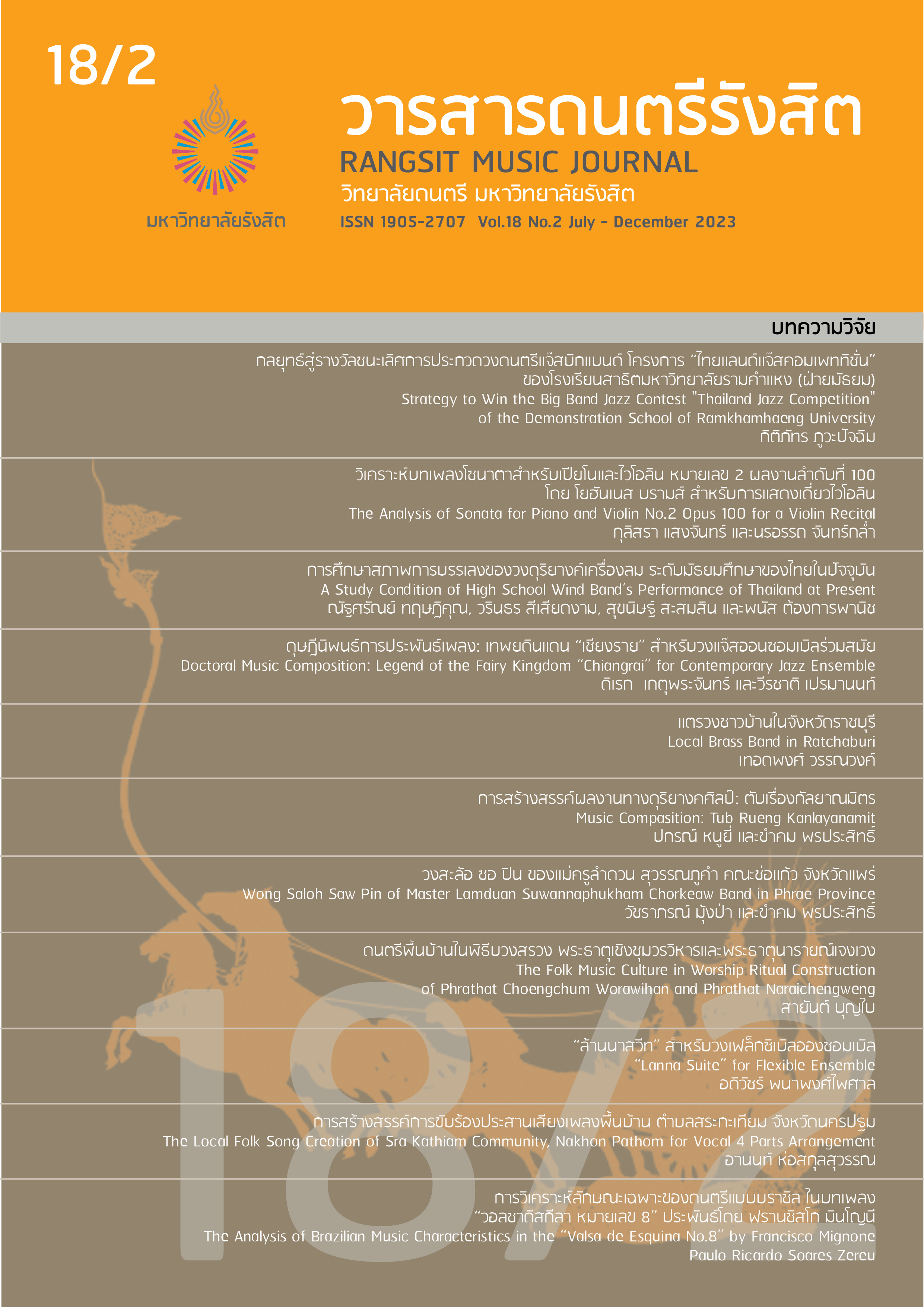แตรวงชาวบ้านในจังหวัดราชบุรี
คำสำคัญ:
แตรวงชาวบ้าน, ราชบุรี, เพลงมาร์ช, เพลงไทยบทคัดย่อ
งานวิจัยฉบับนี้ มีวัตถุประสงค์ศึกษาความเป็นมา บทเพลง การบรรเลง การประกอบอาชีพนักดนตรี การสืบทอด ปัญหาการบรรเลง ปัญหาการประกอบอาชีพนักดนตรี ปัญหาการสืบทอด แนวทางแก้ไขปัญหาและส่งเสริมอนุรักษ์ เป็นการดำเนินการวิจัยเชิงคุณภาพ เครื่องมือที่ใช้ในการวิจัยคือ แบบสัมภาษณ์ การสัมภาษณ์ การสังเกตการณ์แบบมีส่วนร่วมและแบบไม่มีส่วนร่วม จัดสนทนากลุ่ม 2 กลุ่ม กลุ่มละ 10-20 คน นำเสนอผลการศึกษาด้วยวิธีพรรณนาวิเคราะห์
ผลการวิจัยพบว่า แตรวงชาวบ้านในจังหวัดราชบุรีมีมากว่า 94 ปี บรรเลงงานมงคล อวมงคล โดยบรรเลงเพลงมาร์ช เพลงไทย เพลงสมัยนิยม สืบทอดโดยความจำและการบันทึกโน้ต รายได้บรรเลงครั้งละ 350-1,000 บาทต่อคน งานรับจ้าง 3-4 ครั้งต่อเดือน ก่อนเข้าพรรษามีงานประมาณ 10 งานต่อเดือน การบรรเลงเพลงมาร์ชและเพลงไทยเป็นเอกลักษณ์โดดเด่น ในอดีตบรรเลงเป็นจำนวนมาก ปัจจุบันบรรเลงเพลงมาร์ช 1-3 เพลง เพลงไทย 5-10 เพลง เกิดความเสี่ยงต่อการสูญหายจากปัญหาบรรเลงไม่ถูกต้องตามทำนองเดิมและไม่นิยมนำมาบรรเลง ผู้วิจัยเสนอแนวทางแก้ไขปัญหา ดังนี้ นักดนตรีควรร่วมฝึกซ้อมกับกลุ่มนักดนตรีเชี่ยวชาญ หัวหน้าคณะควรกำหนดนักดนตรีรุ่นใหม่ฝึกเพลงมาร์ช เพลงไทย เป็นเพลงแรกอย่างละ 1-3 เพลง ผลการดำเนินโครงการส่งเสริมและอนุรักษ์ทำให้นักดนตรีบรรเลงเพลงมาร์ชและเพลงไทยได้มากขึ้น
เอกสารอ้างอิง
Amatyakul, Poonpit. “A Short History of Origin of Brass Band in Europe and America and Military Band in Thailand.” In Siamese Horned, edited by Poonpit Amatyakul and Nachaya Natchanawakul. 37-46. Bangkok: Amarin Printing & Publishing. 2016. (in Thai)
Bussabong, Princess Sirirat and Poonpit Amatyakul. Prince Paribatra and Music. Bangkok: Chanvanitch, 1981. (in Thai)
Charoensook, Sugree. Horn and Brass Band of Siamese. Bangkok: Dr.Sax, 1996. (in Thai)
Leesomboonphol, Peerachai. Music in Ratchaburi. Ratchaburi: Muban Chombueng Rajabhat University, 2009. (in Thai)
Phancharoen, Natchar. Music Dictionary. 5th ed. Bangkok: Katecarat, 2021. (in Thai)
Pidokrajt, Narongchai. Encyclopedia of Thai Music Repertoire. Nakhon Pathom: Mahidol University Press. 2014. (in Thai)
__________. “The Significance of Pleng-rueang towards the Development of Potential of Thai Musicians.” Journal of Fine and Applied Arts Chulalongkorn University 7, 1 (2020): 43-59. (in Thai)
Rojanatrakul, Satana. Brass Marching Band. Bangkok: Odeonstore, 2016. (in Thai)
Sangaroon, Jarernchai, Chalermsak Pikulsri and Surapol Nesusin. “Adaptation of Tai Yai Music Culture in Northern Thailand.” Rangsit Music Journal 17, 2 (2022): 30-44. (in Thai)
ดาวน์โหลด
เผยแพร่แล้ว
รูปแบบการอ้างอิง
ฉบับ
ประเภทบทความ
สัญญาอนุญาต
ลิขสิทธิ์ (c) 2023 วารสารดนตรีรังสิต

อนุญาตภายใต้เงื่อนไข Creative Commons Attribution-NonCommercial-NoDerivatives 4.0 International License.







